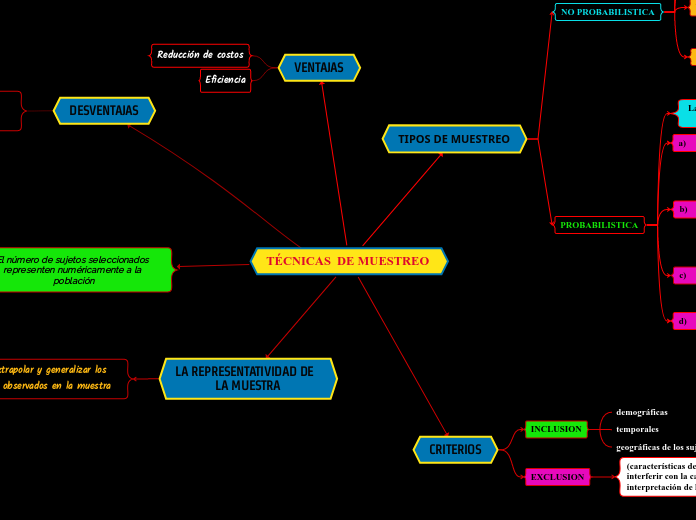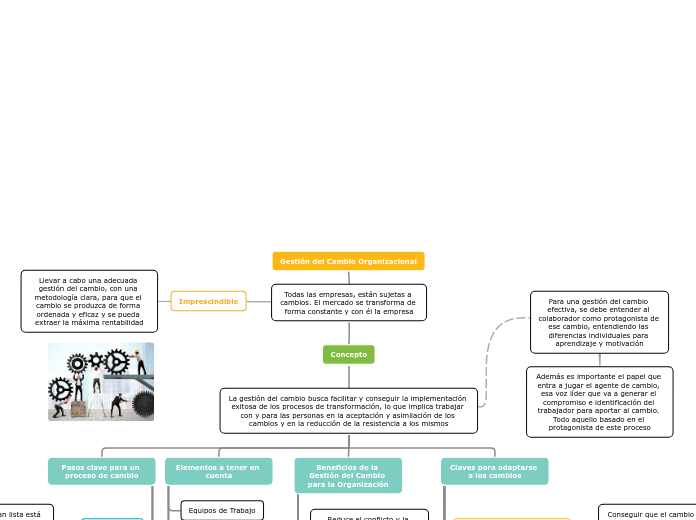TÉCNICAS DE MUESTREO
To name your story, you have to think about the overall message and what you want your audience to understand from the story. Also, make it relevant and easy to remember.
VENTAJAS
Eficiencia
Reducción de costos
DESVENTAJAS
Inadecuada representación de la población blanco:
El número de sujetos seleccionados representen numéricamente a la población
LA REPRESENTATIVIDAD DE LA MUESTRA
The ending of a story is essential. We all know that if the ending is weak, what happened before loses its importance. So make it unpredictable, but fair. A resolved ending answers all the questions and ties up any loose threads from the plot.
permite extrapolar y generalizar los resultados observados en la muestra
This is the closure section of the story.
See examples of possible outcomes below:
- all problems have been solved
- it's clear how each one of your characters ends up
- your main character is transformed by the challenge
población blanco
población accesible
Try answering these questions to come up with a closure:
- Have all the problems been solved?
- Is there a clear picture of what happens with each character in the story?
- Has the challenge transformed your main character?
- How do the characters feel in the end?
CRITERIOS
The middle of the story is where you add layers of complications that will lead to the end. Reveal more about the character's journey. Did their personality go through changes? How did they overcome the challenges? And as you build up the story’s central conflict, make it more personal to that character. Also, from the middle act, you have to lead into the final act.
EXCLUSION
Your character(s) need(s) motivation in order to solve the challenge(s).
(características de los sujetos que pueden interferir con la calidad de los datos o la interpretación de los resultados)
Why does your character need to confront this challenge? What does he/she expect to accomplish by solving it?
See a few examples:
- will marry in 3 days
- can fix the mistakes of the past
Motivation
INCLUSION
Each story has a main character and that character usually needs to solve a problem or challenge. The character's challenge is the one that creates tension throughout the story.
geográficas de los sujetos
temporales
demográficas
Type in any other challenges which other characters in the story need to face.
TIPOS DE MUESTREO
In the beginning of the story (or the exposition), you will need to introduce the setting and characters. You might also want to introduce the main conflict. This part of the story is important because it gives the reader necessary background information and maybe even a first insight into a character’s personality.
PROBABILISTICA
d) Por conglomerados
Formando conglomerados
Se toma la muestra de cada conglomerado de forma aleatoria.
Se utiliza para poblaciones grandes y dispersas
c) Aleatorio sistemático
El criterio de distribución de los sujetos a estudio en una serie es tal, que los más similares tienden a estar más cercanos.
b) Aleatorio estratificado
La base de la estratificación se basa en variables
The most affected character is the main character. Write down here if he/she is affected by these weather conditions in any way. For example, if they lost a family member or their home during a hurricane, etc.
Edad
nivel socio economico
Sexo
Para seleccionar y extraer de ellos la muestra
Se determina los estratos que conforman la población blanco
Does your story include catastrophic weather? See a few suggestions below or add your own:
- hurricane, earthquake, storm, etc
Se define como estrato a los subgrupos de unidades de análisis
a) Aleatorio simple
Todos los individuos que componen la población blanco tienen la misma oportunidad de ser incluidos en la muestra
La probabilidad que cada individuo de estudio tiene de ser incluido en la muestra
Alto grado de certeza
NO PROBABILISTICA
The setting (time & place) of a story can change throughout the plot.
c) Accidental o consecutivo
Sensory details include sight, sound, touch, smell, and taste. These details are important because they create depth in your setting.
See a few examples below:
- the smell of fresh bread
- the scent of freshly cut grass
- rain falling onto the windshield etc.
Se elige un lugar, a partir del cual reclutan los sujetos a estudio de la población que accidentalmente se encuentren a su disposición
Se eligen de manera casual
Reclutar casos hasta que se completa el número de sujetos necesario para completar el tamaño de muestra deseado
b) Por conveniencia
The weather is an important element in your story because it can highly influence the ambiance and the mood of the characters.
Permite seleccionar aquellos casos accesibles que acepten ser incluidos
Decide if you want to include an element of nature in your story. For example, a rainbow can be a very nice choice for a happy ending. The mist in a story can represent mystery and secrets. A thunder can appear in the background at the moment when the 'bad guy' of the story makes its appearance, etc.
a) Intencional
The time of the story can also change. It can describe the event of a single day or can include an entire year's plot. Anyway, don't forget to mention it.
Permite seleccionar casos característi- cos de una población limitando la muestra sólo a estos casos
Los sujetos a estudio dependerá de ciertas características, criterios, etc. que el investigador considere en ese momento
Your story can take place wherever your imagination will take you to.
For example: in an elevator, in an enchanted forest, etc. Don't forget to give details of the environment each time the setting changes, otherwise, the story can be confusing. Also, mention the seasons as each of them has unique weather and events.
poco válidos y confiables o reproducibles










